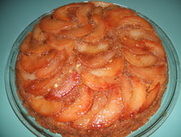 Spicy Pear Upside-Down Cake
Spicy Pear Upside-Down Cake I'm not sure why I love upside-down cakes, maybe it's the caramelized sugar and fruit on top, or just their simplicity. You can turn almost any recipe into an upside-down cake. There are a few types of cakes that will not work, for example an angel food cake or chiffon cake are to delicate to support the weight of the fruit topping. Also a flourless cake is not the best option. But any kind or yellow, spice or pound cake will work. If your recipe is a layered cake cut the batter ingredients in half so it makes a single layer.
The simple magic of caramelized fruit works with pears, apples, peaches, plums, oranges, berries, banana, cranberries, and pineapples. In the bottom of a 10 inch cast iron skillet melt 1/2 c. butter (113g) and 2/3 c. sugar (145g). As the butter melts combine it with the sugar. At this point you may add 1/2 tsp cinnamon, ginger, nutmeg what ever you think will go with your selection of fruit. Then add the thinly sliced apples, pears or your fruit of choice. Arrange the fruit slices decoratively in the skillet. Cook the mixture, undisturbed for about 25 minutes or until the fruit is tender and the sugar is a golden caramel color and thick.
Nuts also work as a caramelized topping. Consider adding nuts to your fruit, or skip the fruit entirely and just go with the nuts. For a cake that has fruit in the batter already, like a banana cake, a topping of caramelized nuts would be tasty.
Then pour the cake batter over the caramelized fruit or nut mixture, being careful not to disturb the arranged fruit. Bake according to the cake directions for time and temperature. When done you need to flip it to reveal the decorative caramelized fruit topping.
Timing is critical in order get a good looking topping. You want the cake pan to be cool enough to not burn you when you flip it, but still warm enough that the caramelized fruit will release easily from the bottom of the pan.
Let it cool on a wire rack for at least 10 minutes and up to half an hour, then lay a flat plate over the top of the cake pan. Carefully flip the cake over onto the plate. Bang on the bottom of the pan for good measure, then lift the pan straight up and off. If a few pieces of fruit decide not to leave the pan, don't worry; just peel them off and arrange them back into the topping. Since the cake is still warm, they'll re-congeal just fine. This is another reason not to wait to flip your cake until it's cooled completely.
I have 2 upside-down cake recipes on my blog for you to try.
Spicy Pear Upside-Down Cake
Cranberry Upside-Down Cake
Source:
Epicurious; Turn Your Cakes Upside-Down
Anna Stockwell
The simple magic of caramelized fruit works with pears, apples, peaches, plums, oranges, berries, banana, cranberries, and pineapples. In the bottom of a 10 inch cast iron skillet melt 1/2 c. butter (113g) and 2/3 c. sugar (145g). As the butter melts combine it with the sugar. At this point you may add 1/2 tsp cinnamon, ginger, nutmeg what ever you think will go with your selection of fruit. Then add the thinly sliced apples, pears or your fruit of choice. Arrange the fruit slices decoratively in the skillet. Cook the mixture, undisturbed for about 25 minutes or until the fruit is tender and the sugar is a golden caramel color and thick.
Nuts also work as a caramelized topping. Consider adding nuts to your fruit, or skip the fruit entirely and just go with the nuts. For a cake that has fruit in the batter already, like a banana cake, a topping of caramelized nuts would be tasty.
Then pour the cake batter over the caramelized fruit or nut mixture, being careful not to disturb the arranged fruit. Bake according to the cake directions for time and temperature. When done you need to flip it to reveal the decorative caramelized fruit topping.
Timing is critical in order get a good looking topping. You want the cake pan to be cool enough to not burn you when you flip it, but still warm enough that the caramelized fruit will release easily from the bottom of the pan.
Let it cool on a wire rack for at least 10 minutes and up to half an hour, then lay a flat plate over the top of the cake pan. Carefully flip the cake over onto the plate. Bang on the bottom of the pan for good measure, then lift the pan straight up and off. If a few pieces of fruit decide not to leave the pan, don't worry; just peel them off and arrange them back into the topping. Since the cake is still warm, they'll re-congeal just fine. This is another reason not to wait to flip your cake until it's cooled completely.
I have 2 upside-down cake recipes on my blog for you to try.
Spicy Pear Upside-Down Cake
Cranberry Upside-Down Cake
Source:
Epicurious; Turn Your Cakes Upside-Down
Anna Stockwell
 RSS Feed
RSS Feed
